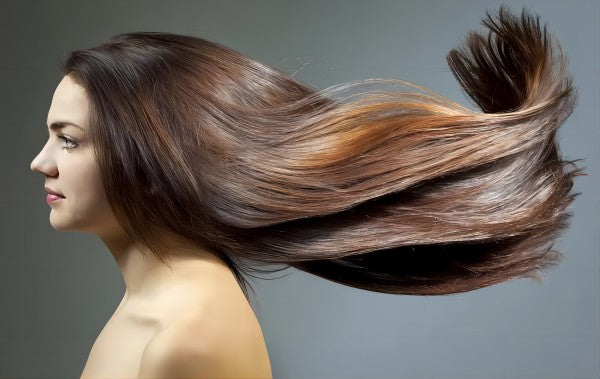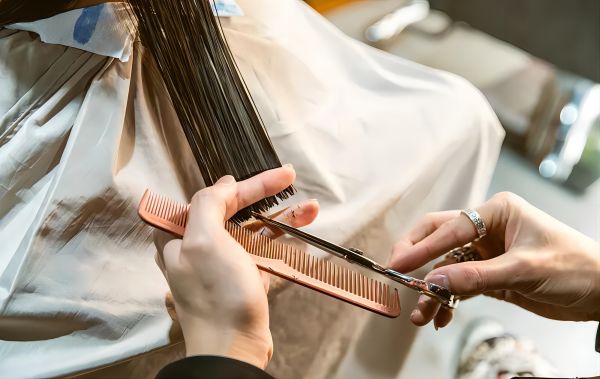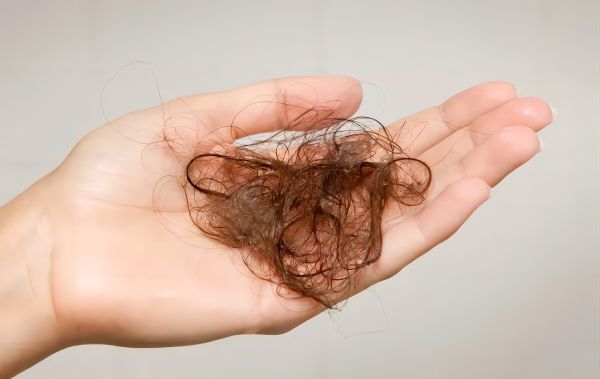Hair typically grows at a monthly rate of half an inch, resulting in an annual growth of approximately 6 inches for the average person. However, individuals with an extended hair growth phase may experience strands reaching impressive lengths.
Some people do the opposite. So you are left with the question:" Why has my hair stopped growing? "
Signs of Stunted Growth
Our hair is like a silent messenger, communicating with us about its health. Recognizing these signals is crucial in identifying and addressing issues that might be hindering your hair's growth potential.
Excessive Shedding:
One prominent sign that your hair might be facing growth challenges is excessive shedding. It's normal to lose some hair every day, but if you're finding more strands than usual on your hairbrush or in the shower drain, it could be an indicator of an underlying problem.
Lack of Thickness:
Another red flag signaling stunted growth is a noticeable lack of thickness in your hair. If you find that your once-voluminous mane is now looking limp and lackluster, it could be an indication that your hair isn't growing as robustly as it should.
Slow Growth Rates:
Perhaps the most direct indicator of stunted growth is, well, slow growth rates. If you're eagerly awaiting longer locks but notice that your hair seems to be taking its sweet time, there's likely an issue affecting the growth cycle. Various factors, including genetics, diet, and overall health, can influence the speed at which your hair grows.
Why Early Recognition Matters:
Recognizing these signs early on is not just about acknowledging the problem; it's about taking proactive steps to address them. Hair growth issues are often easier to manage when identified in their early stages. For instance, adjusting your diet to include essential nutrients for hair health, modifying your styling practices to minimize damage, and adopting stress-relief techniques can all contribute to fostering a more favorable environment for your hair to thrive.
Split Ends and Breakage: Enemies of Lengthy Locks
Nothing sabotages hair growth like split ends and breakage. We'll discuss the impact of these common issues on the overall length of your hair.

- The Culprits: Split Ends and Breakage:
Before diving into solutions, let's identify our foes. Split ends occur when the protective outer layer of the hair, the cuticle, becomes damaged, causing the hair to split into two or more strands. Breakage, on the other hand, involves the actual snapping or breaking of the hair shaft. Both issues are often the result of external stressors, such as excessive heat, harsh chemicals, or mechanical strain from brushing and styling.
- Impact on Overall Length:
The repercussions of split ends and breakage extend beyond aesthetics. When left unchecked, these issues hinder the overall length of your hair. Split ends can travel upward along the hair shaft, leading to more significant damage and breakage. This not only impedes growth but also compromises the quality of your hair. The cumulative effect of ongoing damage may necessitate more drastic haircuts to remove compromised sections, hindering your journey to longer locks.
- Addressing Split Ends for Longevity:
Addressing split ends is a pivotal step in promoting longer, healthier hair. While trims are essential, adopting a holistic approach to prevent split ends is equally crucial. Minimize heat styling, avoid harsh chemical treatments, and adopt a gentle hair care routine. Regular moisturizing treatments and protective hairstyles can further contribute to the prevention of split ends, fostering an environment where your hair can thrive and grow.
- Prevention for Length Retention:
In the battle against split ends and breakage, prevention is your most potent weapon. By addressing these issues promptly and consistently, you eliminate obstacles that could impede your hair's growth. Embrace protective styling, minimize exposure to damaging practices, and incorporate regular trims into your hair care routine. This proactive approach ensures that your hair remains strong, resilient, and on the path to achieving the length you desire.
Hot Tools and Hair Growth: Finding the Balance
Styling tools can be both a blessing and a curse for our hair. Excessive use of heat can lead to damage and breakage.
-
The Blessing and Curse of Styling Tools:
Styling tools, from curling irons to straighteners, empower us to achieve diverse hairstyles. However, their excessive use can be detrimental to the health of our hair. High temperatures from these tools strip away the hair's natural moisture, leading to dryness, breakage, and split ends.
-
The Impact of Excessive Heat on Hair:
To understand the importance of finding a balance, we must grasp the impact of excessive heat on hair. High temperatures can compromise the outer layer of the hair, known as the cuticle, resulting in frizzy, brittle strands. Prolonged exposure weakens the protein structure of the hair, making it prone to breakage and stunted growth. It's not just about achieving a desired style; it's about preserving the health of your hair in the styling process.

Scalp Health 101: A Key to Unlocking Hair Growth Potential
Impediments to Growth: Dandruff and Product Buildup: Dandruff and product buildup are common culprits that impede hair growth. Dandruff, characterized by flaky and itchy skin, can lead to inflammation and hinder the hair growth cycle. Product buildup, resulting from the accumulation of styling products and residues, can clog hair follicles, preventing new hair from emerging. Recognizing these impediments is the first step toward fostering a healthier scalp.
Let's delve into some practical solutions based on the content discussed in the blog. Each solution corresponds to the specific issues raised in the respective paragraphs:
How To Do:
Excessive Shedding, Lack of Thickness, and Slow Growth Rates:
- Solution: Focus on a well-rounded diet that includes biotin-rich foods (eggs, nuts, avocados), vitamins (berries, citrus fruits, sweet potatoes), omega-3 fatty acids (fatty fish, flaxseeds), and iron (lean meats, beans, leafy greens). Additionally, manage stress through relaxation techniques and adopt a scalp massage routine to enhance blood circulation.
Split Ends and Breakage:
- Solution: Schedule regular trims every 8-12 weeks to prevent split ends from traveling up the hair shaft. Implement a gentle hair care routine, minimizing heat styling and avoiding harsh chemicals. Opt for protective hairstyles, use a wide-tooth comb for detangling, and consider silk or satin pillowcases to reduce friction and breakage.
Hot Tools and Hair Growth:
- Solution: Strike a balance by limiting the frequency of heat styling, opting for natural styles on occasion. Always use a heat protectant before styling to create a barrier between your hair and high temperatures. Embrace occasional breaks from styling tools, allowing your hair to recover naturally.
Scalp Health Issues - Dandruff and Product Buildup:
- Solution: Incorporate regular scalp exfoliation using specialized shampoos or DIY exfoliants with ingredients like sugar or coffee grounds. Choose anti-dandruff shampoos with active ingredients for managing dandruff. Clarify your hair periodically to remove product buildup using a clarifying shampoo or apple cider vinegar rinse.





